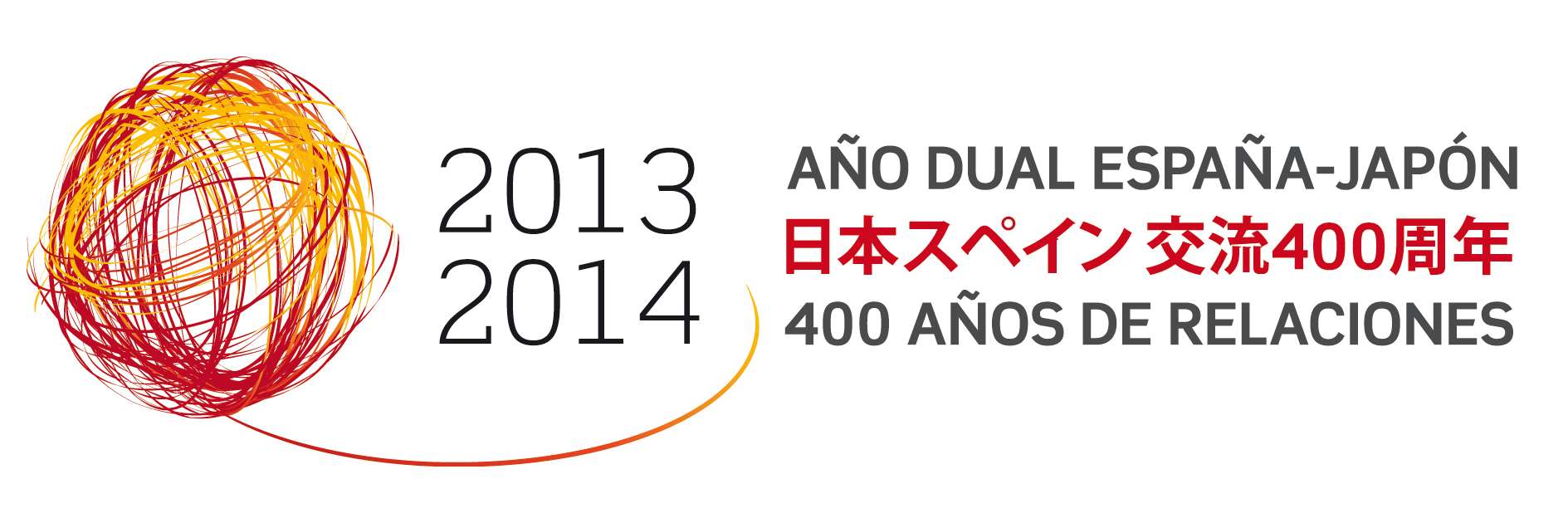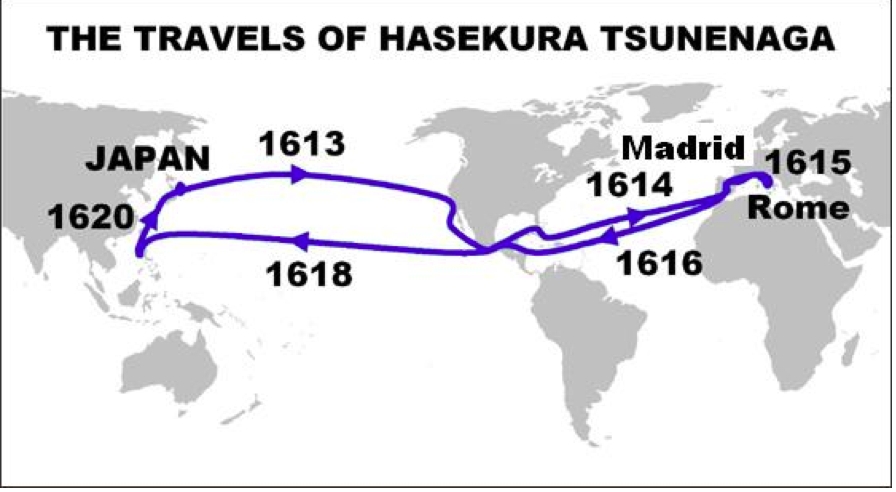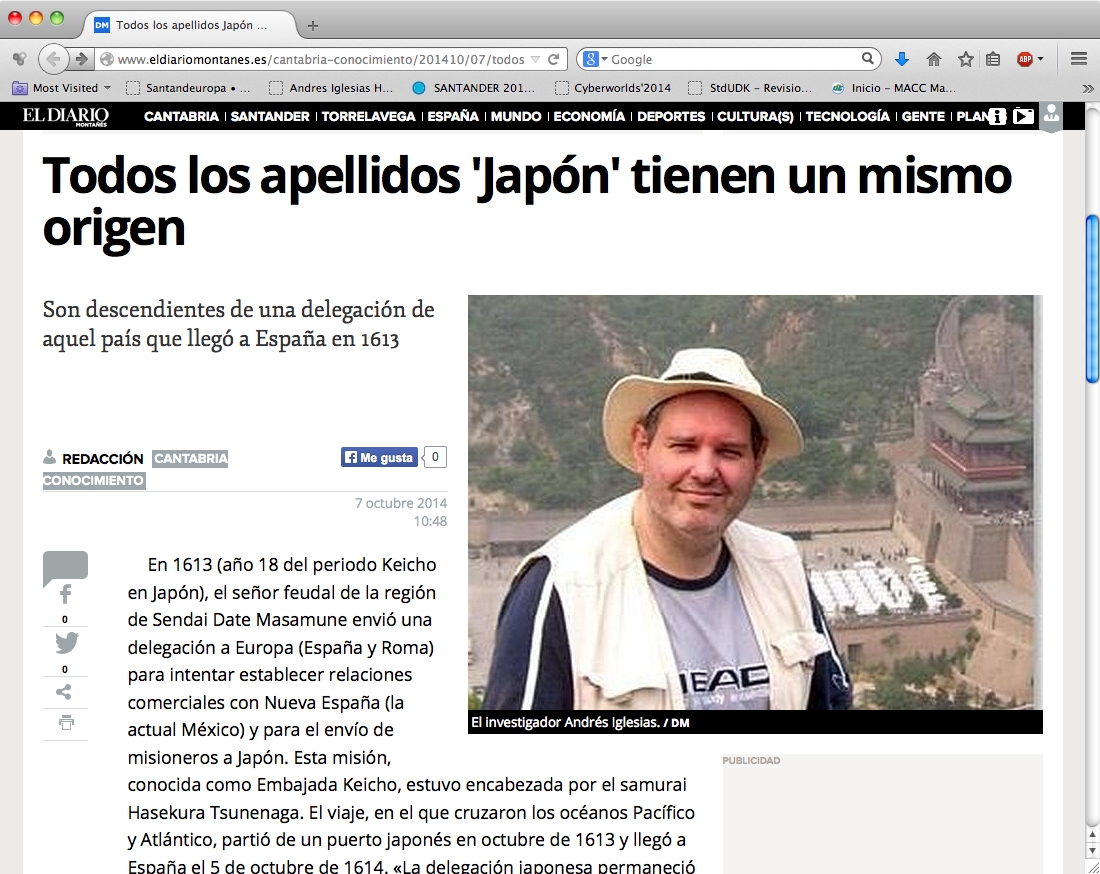Cyberworlds 2014:
Event of the 400 Years of Spain-Japan Relationship
In 1613 (year 18 of the Japanese Keicho Period), the feudal lord Date Masamune (1567-1636) of the domain of Sendai decided to send a delegation to Europe (Spain and Rome) in order to request the establishment of trade relations with New Spain (Mexico) and sending missionaries to Japan. This mission – known as Keicho Embassy to Europe – was headed by Samurai Hasekura Tsunenaga (1570-1621) and the Spanish Franciscan friar Luis Sotelo. The mission, having left Sendai, Japan, in October 1613, arrived in Spain in October 1614 after crossing the Pacific Ocean and the Atlantic Ocean. Hasekura subsequently visited othr cities such as Madrid and Rome. After staying some time in Coria del Río, Sevilla, he returned to Japan in 1620.
The Keicho Embassy was first formalized diplomatic delegation sent by Japan to Spain and has gone down in history for being an important event in the Hispano-Japanese bilateral relations.
In September 2010, the Heads of Government of Spain and Japan agreed to celebrate a «Spain-Japan Dual Year» in 2013 and 2014, as a commemoration of the 400 years of the Spanish-Japanese relationships. The celebration includes a wide variety of cultural, scientific, technological, artistic, and touristic activities to promote mutual understanding between Japan and Spain and open new horizons in bilateral relations in the future.
We are proud that CYBERWORLDS’2014 has been elected as one of the scientific events of this 400 Years of Spain-Japan Relationship (in Spanish/ in Japanese). Our readers would like to know some interesting facts connecting both events:
- The Keicho Embassy trip started at Tsukino-ura bay (Sendai prefecture) on 28 October 1613. CYBERWORLDS’2013 congress was held in a Japanese port (Yokohama), 21-23 October 2013, 400 years after the start of the trip of the Keicho Embassy to Europe.
- According to the historical records, The Keicho Embassy landed at Spain on 5 October 1614. With amazing similarity, CYBERWORLDS’2014 has been officially inaugurated on 5 October 2014 with a reception hosted by the city of Santander in the Royal Palace of La Magdalena. The «symbolic» trip of the CYBERWORLDS conference from Japan to Spain reproduces the route of the actual journey of the Keicho Embassy following the same path 400 years ago.
- CYBERWORLDS’2014 has been organized in close collaboration between Spanish and Japanese institutions, particularly the Group of Computer Graphics and Geometric Modeling of the University of Cantabria (Santander, Spain) and the Faculty of Sciences of Toho University (Funabashi, Japan).
Finally, we would like to express our sincere thanks to the Japanese Embassy at Madrid for their acceptance and support to CYBERWORLDS’2014 as an event of the 400 Years of Spain-Japan Relationship.
Andrés Iglesias Prieto, Akemi Gálvez Tomida
Cyberworlds 2014 Local Organizing Chairs
Hasekura Tsunenaga Today
When Hasekura Tsunenaga came back to Japan, the country had changed drastically and a new policy of international isolation had been set up. As a consequence, the trip was forgotten in Japan for many years, only re-discovered by the time of a new Japanese Embassy to Europe in 1873. But Hasekura Tsunenaga was never forgotten in Spain. In fact, there are about 650 direct descendants — most having the family name Japón (Japan), which is absolutely unusual in Spain — of the original members of Keicho Embassy
still living in Sevilla, particularly in Coria del Rio, the city where Hasekura Tsunenaga lived during his time in Spain. That family name appeared on an official document in 1646 for the first time ever. Current Japón group includes professors, engineers and medical doctors. One was even selected as Miss Spain.
In 1989, to commemorate the founding of the city of Sendai, some research about the city was conducted, and a series of papers by Date Masamune, great Lord of Sendai, where found. In them, the mission of Hasekura was mentioned. It led to the contact with Coria del Rio city looking for more information on that event. Seville City Council sent to Sendai one of the Tsunenaga letters, preserved there, and explained the case of the Japanese descendants of Coria del Río, news published in the popular Japanese newspaper Asahi. In May 1992, on occasion of the Expo 1992 in Seville, a statue of Hasekura Tsunenaga was erected in Coria del Rio with support of the Sendai municipality.
An animation film produced by Spanish company Filmax International and titled Gisaku was released in 2005. The plot of the film, the adventures of a young Japanese samurai named Yohei who visited Spain in the 17th century, is inspired by the travels of Hasekura Tsunenaga. This was the first anime-style film made in Spain and Europe. Computer-generated movies are one of the topics of Cyberworlds 2014.
See the news about the «Japón» as published by:
EL DIARIO MONTAÑES: (largest regional newspaper)
October 7th 2014: Todos los apellidos «Japón» tienen el mismo origen (All people with family name Japan share the same origin)


